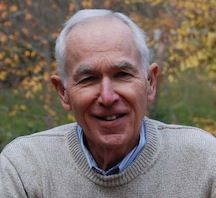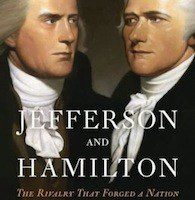Imagine turning on cable news to footage of Tea Party mobs burning a scarecrow Katherine Sebelius at the stake, or Joe Biden shooting Chris Christie to death with a pistol on a Potomac riverbed. It is true that we live in partisan times, but the rancor on FOX and MSNBC is nothing new. In fact, America was born in an age whose feverish partisanship makes today’s behavior look downright congenial. In the summer of 1794, after negotiating a trade treaty that the opposition found unfavorable, foreign minister John Jay was burned in effigy; it was said you could travel from Baltimore to Atlanta by the light of the bonfires. Aaron Burr, then sitting vice-president, did kill the leader of the opposition party in a duel. When Thomas Jefferson was elected president, religious conservatives told their constituencies to bury their Bibles, that Jefferson would be showing up with an army at his back to confiscate all Christian materials. “Death panels” are boring in comparison.
Though the seeds of the American political divide can be traced back to the first organized societies, this particular conflict began in the cabinet of George Washington. Alexander Hamilton, the secretary of the treasury, and Thomas Jefferson, the secretary of state, disagreed on whether the Constitution allowed for the establishment of a national bank. The argument that resulted was the country’s first Constitutional controversy—does the “necessary and proper” clause permit all that is necessary and proper, or are there defined limits to the scope of the federal government? It’s an interesting historical situation given the frequent assertions of today’s political actors that there exists some monolithic intent of the Founding Fathers. Most of the men who wrote the Constitution were alive and serving in government and still they could not agree on the exact meaning of the document.
John Ferling’s Jefferson and Hamilton is the latest in his impressive string of thick, rollicking histories. Here, Ferling brings us to America’s first state of open party warfare through a dual biography of the factions’ most prominent leaders. Ferling uses the lives of Jefferson and Hamilton draw into sharp contrast the worldviews that shaped the movements they led.
Think of those cabinet arguments as the big bang of mainline American political philosophy. Two men, united in revolution, were now clashing intellects at the crossroads of what would come next. Jefferson imagined an agrarian republic, perhaps even someday freed of slaves; a place where each person is his own private entity, self-sufficient and so not beholden to commerce, industry or government. Jefferson was more concerned with unleashing the mind than empowering material advancement. His Americans were humble and enlightened creatures of the earth. For Hamilton, America’s true potential was as an empire, where titans of industry and finance would dominate a global market, “a nation with the capability of marshalling wealth and utilizing the power brought by wealth for military means.” A standing army, a funded debt, a central bank were not only good ideas, but essential for America’s survival.

When Washington sided, finally, with Hamilton, the Federalist platform was put in place. Jefferson became distraught. He was convinced that “the evil genius of America,” had used his “guile” and “political dexterity” to bamboozle the old general. It is ironic that Hamilton’s success at political persuasion is what pushed Jefferson to unleash his own most powerful skill—that of a political boss. Jefferson began organizing opposition to the Federalist program, and America’s first party system was born.
The Jefferson whom Ferling so ably brings to life is less a small government firebrand and more a quasi-socialist reformer, pushing for equality and political access through government land grants and education. Jefferson had seen firsthand the horrors of trickle-down economics in France. Put off by the gross wealth discrepancies in the French system, Jefferson merely shrugged when the guillotine was rolled out. The French Revolution had convinced him of one thing: if societies and their governments do not find a way to prevent disruptive concentrations of wealth, then bloody revolt and mayhem will.
Ferling’s Hamilton is still the consummate builder of recent biographies, and no less the intellectual colossus, but he is also a loose cannon, consumed by “long-nourished hatreds, and gnawing ambition,” with a “no-holds-barred” approach that gave his very existence an abrasive edge. Here Hamilton is a sort of Jekyll and Hyde, at battle with a core duality; he is both an expert political administrator and an impulsive, careless reactionary. As the former, Hamilton was unmatched. Passing and then implementing the nation’s first banking system is one of the great feats in American political history. But only with Washington’s mediating hand was Hamilton able to reign in his reactionary side. Five years after the Old Man’s death, through a series of ill-tempered political blunders, Hamilton had destroyed his career. Disgraced by the nation’s first sex scandal, the man who built the US financial system was reduced to firing off ill-thought pamphlets, scheming to subvert democracy when elections did not go his way, and, as a grand finale, forcing himself into a fatal affair of honor.
Perhaps for the calm and serene Jefferson, these flaws in his rival’s character were proof that an America built on Hamiltonian ideals would breed a culture of Hamiltonian men: brash, obstinate, scheming, ruled by passions out of control, shackled to “their unquenchable thirst for money.” Hamilton’s America could never provide the kind of liberty of the mind which Jefferson thought the real end goal of the Revolution.
So who won? Which America are we—Jefferson’s or Hamilton’s? Ferling could not provide a more explicit answer: “The American nation, with its incredibly powerful executive, gargantuan military, repeated intervention in the affairs of foreign states, and political system in the thrall of great wealth, is the very world that Jefferson abhorred.”





One response
It’s Potomac!
Click here to subscribe today and leave your comment.